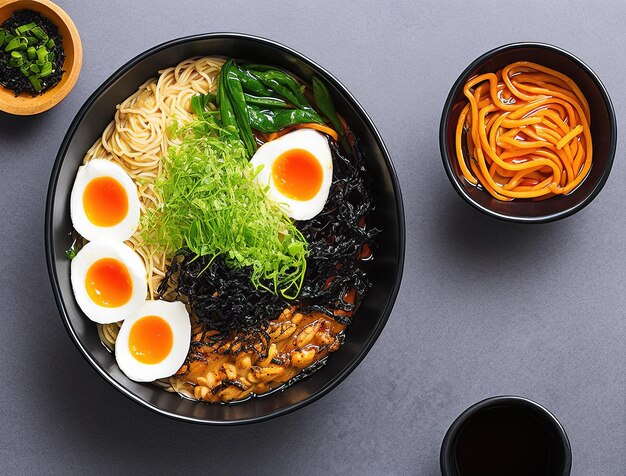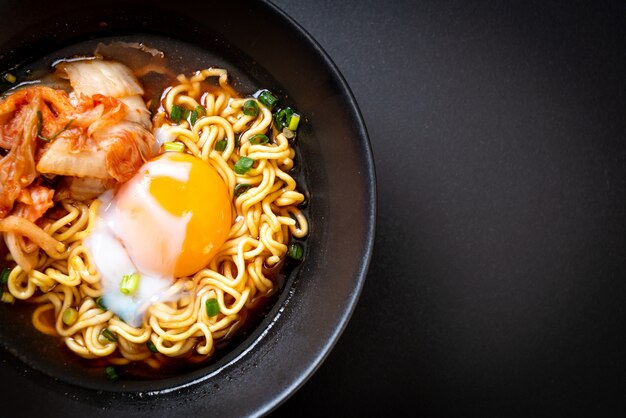Ramen is a beloved dish worldwide, especially in the United States. From traditional Japanese bowls to convenient instant noodles, ramen offers diverse flavors and textures. But with its growing popularity comes a significant question: Is ramen healthy? While it’s undeniably delicious, its nutritional value and potential health concerns spark debate. Let’s dive into what ramen is, its nutritional profile, and the health implications of frequent consumption.
What Is Ramen?
Ramen is a noodle-based dish originating from Japan. It is a comforting meal with a rich broth, noodles, and toppings. Over time, it has evolved into different styles to suit global tastes.
Traditional Japanese Ramen vs. Instant Noodles
- Traditional Ramen: Made with fresh ingredients, including hand-pulled noodles, meat or vegetable broth, and toppings like boiled eggs, seaweed, and vegetables.
- Instant Ramen: A quick, packaged option made with pre-fried noodles and seasoning packets. While convenient, it often contains preservatives and additives.
Nutritional Profile of Ramen
Ramen’s nutritional value depends on the type consumed. Traditional ramen is more balanced, while instant noodles are often less healthy.
Calorie Content
- Traditional Ramen: Contains around 500–700 calories per serving, depending on the broth and toppings.
- Instant Ramen: A single package can range from 350–500 calories, primarily from noodles and oil.
Macronutrients
- Carbohydrates: Both traditional and instant ramen are high in carbs, primarily from wheat-based noodles.
- Proteins: Traditional ramen includes protein from eggs, meat, or tofu. Instant ramen often lacks sufficient protein unless extra ingredients are added.
- Fats: Instant ramen is higher in unhealthy fats due to fried noodles and oil-based flavorings.
Micronutrients
- Traditional ramen contains essential vitamins and minerals from fresh toppings and broth.
- Instant ramen lacks significant micronutrients unless fortified.
Sodium Levels
One of the biggest concerns with ramen is its sodium content.
- Traditional Ramen: Contains 1,000–1,800 mg of sodium per serving.
- Instant Ramen: Packs a staggering 1,500–2,200 mg per package, contributing to excessive daily intake.
Health Concerns Associated with Ramen Consumption
Despite its popularity, ramen has some potential health risks, particularly when consumed regularly.

High Sodium Intake
Instant ramen’s high sodium content can lead to health problems such as:
- Hypertension: Elevated sodium raises blood pressure.
- Cardiovascular Diseases: Increased risk of heart attacks and strokes.
| Sodium Content Comparison | Traditional Ramen | Instant Ramen |
| Average Serving | 1,000–1,800 mg | 1,500–2,200 mg |
| Recommended Daily Limit | 2,300 mg | Often exceeded |
- Saturated Fats and Preservatives
- Many instant ramen products contain saturated fats, which can:
- Harm liver health.
- Lead to weight gain and high cholesterol.
- Preservatives like TBHQ (tertiary butylhydroquinone) may cause long-term health effects if consumed in excess.
Low Nutritional Value
- Instant ramen offers minimal essential nutrients such as vitamins, minerals, and fiber.
- Overreliance on instant noodles may result in nutrient deficiencies.
Metabolic Syndrome Risk
- Studies have linked frequent ramen consumption to metabolic syndrome, particularly in women. This includes:
- Increased waist circumference.
- Elevated blood sugar levels.
- Higher risk of diabetes and heart diseases.
Balancing Ramen in Your Diet
While ramen has its drawbacks, moderation and smart choices can make it part of a healthy diet.
- Opt for Traditional Ramen: Choose freshly prepared bowls with a variety of vegetables and lean proteins.
- Limit Instant Ramen Consumption: If you must have instant noodles, consider:
- Adding vegetables like spinach or broccoli.
- Including a boiled egg or tofu for protein.
- Reducing the seasoning packet to cut sodium.
Related to Read: Rice Noodles vs Egg Noodles: Nutritional Differences, Calories, and Health Benefits
Can Ramen Be Part of a Healthy Diet?
Ramen, a flavorful and satisfying dish, has gained global popularity for its convenience and versatility. However, many people wonder whether ramen can fit into a healthy diet. The answer lies in moderation, ingredient choices, and preparation methods. Let’s explore how you can enjoy ramen while maintaining a balanced and nutritious diet.
Moderation and Portion Control
- Eating instant ramen frequently can lead to excessive sodium and calorie intake.
- Overconsumption may increase the risk of health issues like high blood pressure and weight gain.
Practice Portion Control
- Stick to a single serving size.
- Pair ramen with nutrient-dense side dishes like salads or steamed vegetables to avoid overeating.
Choosing Healthier Options
Not all ramen is created equal. Making smarter choices at the grocery store can significantly impact its nutritional value.
Low-Sodium or Whole Grain Varieties
- Many brands offer low-sodium versions of instant ramen. These options help reduce salt intake.
- Opt for whole-grain noodles for added fiber, which promotes better digestion and satiety.
Homemade Ramen Recipes
- Preparing ramen from scratch allows complete control over the ingredients.
- Use fresh vegetables, lean proteins, and homemade broth to create a nutrient-packed bowl.
Tips to Make Your Ramen Healthier
Enhancing the nutritional content of ramen is simple with a few modifications.

Add Vegetables
Incorporate fresh or frozen vegetables like:
- Carrots, broccoli, and spinach: Rich in vitamins and minerals.
- Mushrooms: Provide antioxidants and a meaty texture.
- Corn and green onions: Add flavor and visual appeal.
Include Lean Proteins
Boost the protein content by adding lean food:
- Chicken: A lean source of protein to keep you full.
- Tofu: Perfect for a vegetarian option with essential amino acids.
- Eggs: A quick and easy way to add protein and healthy fats.
Use Low-Sodium Broth
- Replace the seasoning packet with a homemade or store-bought low-sodium broth.
- Flavor with natural ingredients like garlic, ginger, or soy sauce.
Limit Consumption of Broth
- The broth often contains most of the sodium. Avoid drinking it entirely or consume it sparingly.
Alternatives to Instant Ramen
For those looking to avoid instant ramen entirely, consider these healthier substitutes.
Soba or Udon Noodles
- These traditional Japanese noodles often have a better nutritional profile.
- Soba noodles, made from buckwheat, are high in fiber and protein.
- Udon noodles are soft and can be paired with fresh, light broths.
Zucchini Noodles (Zoodles)
- A low-carb alternative, perfect for those watching their caloric intake.
- Pair with a flavorful broth and lean proteins for a wholesome meal.
Shirataki Noodles
- These calorie-free noodles are made from konjac yam.
- Ideal for individuals managing their weight or following a ketogenic diet.
Conclusion
Ramen can absolutely be part of a healthy diet when consumed thoughtfully. The key is moderation, making healthier ingredient choices, and preparing it with fresh, nutrient-dense additions. By choosing traditional or homemade options and incorporating vegetables, proteins, and low-sodium broth, ramen can transform from a convenient snack to a balanced meal.
Remember, your health journey is about informed choices and balance. Enjoy ramen responsibly and creatively!
FAQs
1. Is traditional ramen healthier than instant ramen?
Yes, traditional ramen is typically healthier. It uses fresh ingredients, such as broth made from scratch, hand-pulled noodles, and nutritious toppings like vegetables and eggs. Instant ramen, on the other hand, often contains high sodium, unhealthy fats, and preservatives.
2. Can I eat instant ramen every day?
It’s not recommended to eat instant ramen daily due to its high sodium and low nutritional value. Frequent consumption can increase the risk of hypertension, cardiovascular issues, and nutrient deficiencies. Aim for occasional indulgence while balancing your diet with healthier meals.
3. How can I make instant ramen more nutritious?
You can enhance the nutritional profile of instant ramen by:
- Adding vegetables like spinach, carrots, or broccoli.
- Including lean proteins like boiled eggs, grilled chicken, or tofu.
- Using only half of the seasoning packet or replacing it with low-sodium broth.
4. Are there low-carb ramen options?
Yes, there are low-carb alternatives like zucchini noodles (zoodles) or shirataki noodles. These options are great for those managing their weight or following low-carb diets while still enjoying a ramen-like experience.
5. What are the risks of eating too much ramen?
Consuming excessive amounts of ramen, especially instant noodles, can lead to:
- High sodium intake, increasing the risk of hypertension.
- Weight gain due to unhealthy fats and calories.
- Nutrient deficiencies, as instant ramen lacks essential vitamins and minerals.

